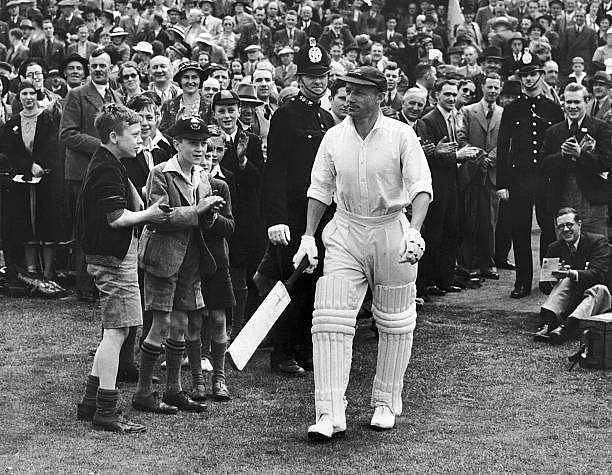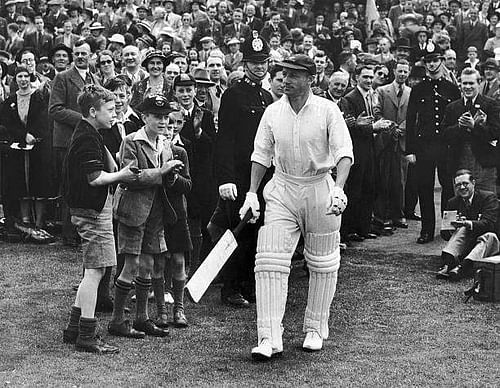
A chink in the Don's armour?
Many liked him. Few loathed him. But almost everyone was in awe of the run machine that Don Bradman was. He had his fair share of critics – most notably his teammates Jack Fingleton & Bill O’Reilly who even mockingly applauded as Bradman walked back after a duck in his final innings. However, while his harshest critics could find faults with Bradman the person, there was precious little they could pick on when they considered Bradman the batsman.
How could they, really? After an inauspicious debut in the 1928-29 Ashes, when he scored 18 and 1 at the Gabba in Brisbane, he was dropped and replaced by Otto Nothling in the second Test. Bradman was back for the very next game and never looked back. He plundered a record 974 runs in the Ashes in 1930 and tormented England virtually every time he took guard against them. took guard against them. Nothling in the second Test. Bradman was back for the very next game and never looked back. He plundered a record 974 runs in the Ashes in 1930 and tormented England virtually every time he took guard against them.
With a stunning tally of 29 centuries (12 of them over 200) in just 52 Tests, Bradman stands on a pedestal of his own. No batsman remotely comes close to his average of 99.94 (the closest is Steve Smith with an average of 61) and his glut of batting records is something that one can only marvel at but never dream of matching. The great British mathematician Dr. Hardy even coined a term ‘Bradman class’ to signify intellectual prodigies and outliers.
All this begs a question – was there really a weakness the man ever had? Or are we really on a futile mission to uncover what perhaps doesn’t exist? Either way, the exercise promises to be exciting.
Bradman had destroyed England’s Ashes hopes singlehandedly in the 1930 series and it had become quite apparent that stopping him would be the only way England could regain the Ashes. Douglas Jardine did just this by employing the leg theory or ‘Bodyline’ as it was infamously called.
Extra Cover: The GOAT debate: Perception vs stat-machines
Bradman was made to look mortal (he still averaged 55) and England triumphed in what was to become one of the most famous & controversial series of all time. However, following Bradman’s protests and the cries of many administrators, the tactic was never quite employed again and the rules of the game were significantly altered to prevent this from reoccurring.
While this does represent a bit of a blip in his otherwise perfect career, it does not quite represent a chink. What is worth investigating is Bradman’s performance on ‘sticky dogs’ – the term given to uncovered wickets affected by rain.
Uncovered wickets represented the toughest challenge to most batsmen in the early part of the 20th century right until the first few years after World War 2 when Australia made covered wickets mandatory.
Why was it such a challenge? ‘Sticky dogs’ would have uneven bounce, aid spinners, make most bowlers a daunting proposition, and were extremely unpredictable. Batsmen had no real way of coping with the variations in bounce and pace. How did Bradman fare on these wickets? Also, how well did other top batsmen perform in such difficult conditions?
Firstly, it is not easy to identify all the matches which were affected by rain and which among those pitches turned out to be a ‘sticky dog’. In some cases, the rain poured down on the third day and rendered a flat wicket (until then) unplayable. In some other cases, a terrible wicket flattened out after a couple of days when the sun shone brightly again.
To address this, I came up with this analysis – Considering the performance of batsmen in matches where the average runs per wicket (RPW) for their team is below the average (less than 90% of the average) for the era (duration of the player’s career).
For instance, if the average runs per wicket for a team during a player’s career is 34, then a tough wicket would be any match where the team has scored at less than 30 runs per wicket. Only matches where at least 10 wickets have fallen will be considered so that outliers and anomalies are eliminated.
While ‘sticky dogs’ might represent a portion of this sample set, the fact is that we are considering almost all contexts when the batsman’s team found the situation (pitch, match context, conditions etc.) challenging. ‘Sticky dogs’ (Uncovered wickets) pretty much stopped being a feature in the game after 1950. Hence, I have considered all matches only until the end of 1950. There were a few sporadic matches in England played even after this period but the sample size is too small to be considered.
C.L.R James, writing in his classic Beyond a Boundary, observes that Bradman might have perhaps been a touch of a fair-weather batsman and that greats such as George Headley (also known as the Black Bradman) and Jack Hobbs might have been better players on tough wickets.
Victor Trumper, widely acknowledged by many as perhaps the finest batsman of his era, was also considered a fantastic player on uncovered wickets. What do the numbers tell us? Let us take a close look.
I have considered seven top batsmen for the analysis. Along with Bradman, the batsmen included are Victor Trumper, George Headley, Wally Hammond, Jack Hobbs, Len Hutton, and Herbert Sutcliffe.
Batsman | Matches | Innings | Runs | Average | 100/50 | Innings per 50+ score |
Don Bradman | 52 | 80 | 6996 | 99.94 | 29/13 | 1.9 |
George Headley | 22 | 40 | 2190 | 60.83 | 10/5 | 2.7 |
Jack Hobbs | 61 | 102 | 5410 | 56.94 | 15/28 | 2.4 |
Victor Trumper | 48 | 89 | 3163 | 39.04 | 8/13 | 4.2 |
Herbert Sutcliffe | 54 | 84 | 4555 | 60.73 | 16/28 | 2.2 |
Len Hutton | 79 | 138 | 6971 | 56.67 | 19/13 | 2.7 |
Wally Hammond | 85 | 140 | 7249 | 58.45 | 22/24 | 3.0 |
The second table compares the career performance of each batsman with the performance in challenging conditions (which includes the uncovered wickets). The percentage of tough runs (PTR) is the proportion of the total career runs that has been scored in these tricky contexts. The average ratio (AR) is the ratio of the batsman’s average in tough conditions to his career average. The higher the ratio, the better the batsman has performed on tricky wickets.
The second metric is the fifties ratio (FR) which compares the ratio of innings/50+ score over the career with the corresponding metric in the matches considered. This will showcase how much tougher the batsman has found it when it comes to dominating the bowling.
Analysis – Challenging conditions (including ‘sticky dogs’)
Batsman | RPW (career) | RPW (tough wickets) |
Don Bradman | 33.98 | 30 |
George Headley | 27.89 | 25 |
Jack Hobbs | 33.30 | 30 |
Victor Trumper | 27.99 | 25 |
Herbert Sutcliffe | 38.95 | 35 |
Len Hutton | 36.75 | 33 |
Wally Hammond | 36.89 | 33 |
| Batsman | Matches | Innings | Runs | PTR | Average | AR | 50+ | Inns per 50+ | FR |
| Don Bradman | 12 | 21 | 779 | 11% | 38.95 | 0.39 | 6 | 3.5 | 1.8 |
| George Headley | 9 | 17 | 474 | 22% | 29.62 | 0.49 | 4 | 4.25 | 1.6 |
| Jack Hobbs | 22 | 41 | 1657 | 31% | 43.60 | 0.77 | 14 | 2.9 | 1.2 |
| Victor Trumper | 22 | 42 | 893 | 28% | 22.32 | 0.57 | 5 | 8.4 | 2.0 |
| Herbert Sutcliffe | 14 | 27 | 980 | 22% | 37.69 | 0.62 | 8 | 3.4 | 1.6 |
| Len Hutton | 18 | 35 | 1025 | 15% | 34.16 | 0.60 | 10 | 3.5 | 1.3 |
| Wally Hammond | 33 | 64 | 1696 | 23% | 28.26 | 0.48 | 14 | 4.6 | 1.5 |
From the numbers, it becomes pretty clear that Bradman scored the majority of his runs in matches where the conditions were quite good for batting. He is perhaps the greatest by a mile when it comes to batting on good tracks. However, let us pause for a moment and see how he performs in tough conditions.
At an absolute level, Bradman’s average is still the second best among the batsmen considered. But consider the drop in the average (AR is 0.4 i.e. average in tough conditions is 40% of his career average) and the fifties ratio (way behind his career numbers – higher the FR, poorer the performance in tougher conditions relative to the overall career). All other players have had a greater PTR when compared to Bradman with Hobbs topping the list at 31%.
Hobbs was always hailed as ‘The Master’ for his ability to come out on top in the most challenging conditions. The numbers undoubtedly reflect this. When the going got tough, Hobbs reigned supreme. He averaged an astonishing 43.60 in these matches and has an AR of 0.77 which is by far the best among these batsmen.
He also made a 50+ score more frequently than all other batsmen and the FR of 1.2 is also exceptional. Perhaps it would be safe to assert that Hobbs was the man when the conditions posed a serious threat to the batsmen.
Len Hutton and Herbert Sutcliffe have similar numbers but Hutton comes out on top on the FR front while Sutcliffe has a higher PTR. Wally Hammond, who was perhaps the best in his era bar Bradman, also suffers a major drop in average in tough conditions.
Victor Trumper, who has always been hailed as one of the finest Australian batsmen, has a very low average and a high FR. However, he has played a major proportion of his career in tough conditions. It does become fairly clear that the love and admiration Trumper got go beyond numbers given that the stats are not the best.
So, there was perhaps some chink in the Don’s armour after all.
Hedley Verity, who dismissed Bradman the most times (8), was among the few bowlers to exploit this weakness. However, Bradman was so far ahead of the curve both in terms of skill and the ability to score massively when the conditions were good. This does ensure that he will continue to stand alone in the pantheon of batting greats.
Fittingly, however, the analysis points to Hobbs as the greatest of foul-weather batsmen.
Madhu has worked in the stats team in ESPN Cricinfo. He spends most of his spare time connecting every number he sees to an obscure stat from the game.
